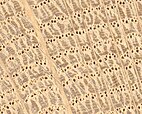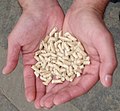Wood science
Wood science[1] is the scientific field which predominantly studies and investigates elements associated with the formation, the physical and chemical composition, and the macro- and microstructure of wood as a bio-based and lignocellulosic material. Wood science additionally delves into the biological, chemical, physical, and mechanical properties and characteristics of wood as a natural material.[2][3]
Deep understanding of wood plays a pivotal role in several endeavors such as the processing of wood, the production of wood-based materials like particleboard, fiberboard, OSB, plywood and other materials, as well as the utilization of wood and wood-based materials in construction and a wide array of products, including pulpwood, furniture, engineered wood products, such as glued laminated timber, CLT, LVL, PSL, as well as pellets, briquettes, and numerous wood-derived products.
History
Initial comprehensive investigations in the field of wood science emerged at the start of the 20th century. In 1902, the Wood Processing Laboratory was founded in the Department of Forestry at Tokyo University and academic studies on wood processing were first initiated. The Forest and Forest Products Research Institute in Tokyo was also established in 1905.[4] In 1906 the Forest Products Research Institute was created in Dehradun, India.
The advent of contemporary wood research commenced in 1910, when the Forest Products Laboratory (FPL) was established in Madison, Wisconsin, USA.[5] The Forest Products Laboratory played a fundamental role in wood science providing scientific research on wood and wood products in partnership with academia, industry, local and other institutions in North and South America and worldwide.[6][7][8]
In the following years, many wood research institutes came into existence across almost all industrialized nations. A general overview of these institutes and laboratories is shown below:[9]
- 1913: Institute of Wood and Pulp Chemistry Eberswalde (today's Eberswalde University for Sustainable Development), Germany
- 1913: Forest Products Laboratory Montreal, Canada
- 1918: Forest Products Laboratory Vancouver, Canada
- 1919: Forest Products Laboratory Melbourne, Australia
- 1923: Department of Mechanics and Wood Technology, University of Sopron, Hungary
- 1923: Forest Products Research Laboratory, Princes Risborough, Great Britain
- 1929: Institute for Wood Science and Technology, Leningrant, St. Petersburg, USSR
- 1933: Centre Technique du Bois, Paris, France
- 1936: Wood Department of the Swiss Federal Laboratories for Materials Testing in Zurich (today's Swiss Federal Laboratories for Materials Science and Technology), Switzerland
- 1942: Laboratory of Wood Technology Helsinki, Finland
- 1944: Swedish Forest Products Research Laboratory, former TRÄTEK (today's Research Institutes of Sweden), Sweden
- 1946: Latvian Academy of Sciences, Institute of Wood Chemistry, Latvia
- 1946: Institute for Wood Research, iVTH (today's Fraunhofer Institute for Wood Research), Germany
- 1947: State Wood Research Institute Bratislava, Slovakia
- 1947: Forest Research Institute – Rotorua (today's Scion), New Zealand
- 1948: Austrian Wood Research Institute Vienna (today's Holzforschung Austria), Austria
- 1949: Norwegian Institute of Wood Technology, Norway
- 1950: Federal Institute for Forestry and Forest Products (today's Johann Heinrich von Thünen Institute), Germany
- 1952: Institute for Wood Technology and Fibers (today's Institute for Wood Technology Dresden), Germany
- 1952: Institute for Wood Research and Wood Technology (today's Wood Research Munich), Germany
- 1954: Faculty of Wood Technology, Poznan University (today's Faculty of Forestry and Wood Technology at Poznan), Poland
From the '60s, the founding of research institutes in the field of wood sciences continued in many universities, and also in universities of applied sciences and technological universities. Today, the International Academy of Wood Science (IAWS), a recognised and non-profit assembly of wood scientists, represents worldwide the scientific area of wood science and all of its associated technological domains.[10][11]
Sub-areas
The field of wood science can be categorized into three distinct sub-areas, which include:[12]
- Wood biology, a subset of wood science which focuses on the formation, structure and composition of wood tissues. It involves investigations conducted at the macroscopic, microscopic, and molecular levels. Additionally, this sub-field encompasses wood anatomy which involves the (macroscopic - microscopic) identification of various wood species.[13]
- Wood chemistry, whose primary focus is the analysis of the chemical constituents comprising wood, with specific emphasis on cellulose, lignin, hemicelluloses, and extractives, as well as on the various products derived from these components. It is also explores potential uses for pulp and paper production, the utilization of wood and wood waste, the generation of energy and chemicals from pulping byproducts, and the conversion of biomass.
- Wood physics, which constitutes an essential component of the field of wood science, building upon discoveries in wood chemistry, wood anatomy (xylem), and biology, as well as principles from classical physics, mechanics, and materials strength.[14] Wood physics encompasses critical research areas including: a) examining wood behaviour in relation to moisture, which involves fundamental aspects of moisture absorption, swelling, and shrinkage, b) investigating the impact of temperature on wood properties, encompassing heat conduction and heat storage, and c) assessing the mechanical, rheological, and acoustic properties and qualities of both wood and wood-based products.
- Some indicative examples involving fundamental principles of wood sciences
- Inside a modern sawmill equipped with laser-guided technology. Following logging, it all commences with the sawmilling of round timber.
- A kiln dryer is typically utilized in the drying of green timber, applying a procedure which involves fundamental principles of physics.
- Railroad wooden ties that are fully impregnated with creosote through a process known as pressure treatment, which is a common method for preserving wood.
- Steam bending is a woodworking technique, under which, wood is exposed to steam and its basic polymer, lignin is softened.
- Specimen of acetylated wood (Accoya) resulting from the acetylation reaction of wood and acetic anhydride represents a novel development following decades of research.
- Specimen of cross-laminated timber (CLT), a novel engineered wood product for big construction projects (i.e. buildings), which was developed during the ‘90s.
- Terrace built with furfurylated wood (Kebony) resulting from the chemical modification of pine wood by furfuryl alcohol; this presents today a novel green technology.
- Wood pellets, a type of important solid fuel nowadays, is produced from compressed wood residues through pelletizing, involving the softening of lignin.
- Novel device, named as XyloTron, which incorporates microscopic features from the field of wood anatomy, helps today in the accurate and very fast identification of timber in the global trade.
Scientific journals
Below are some of the significant scientific journals within the areas of wood sciences:[15]
- Holzforschung[16]
- European Journal of Wood and Wood Products[17]
- Wood Science and Technology[18]
- Wood Material Science and Engineering[19]
- Cellulose[20]
- Mokuzai Gakkaishi[21]
- Journal of Wood Science[22]
- BioResources[23]
- IAWA Journal[24]
- Maderas: Ciencia y Tecnología[25]
- Wood Research[26]
- Journal of Wood Chemistry & Technology[27]
- Forest Products Journal[28][29]
- Wood and Fiber Science[30]
- Journal of the Korean Wood Science and Technology[31]
- International Wood Products Journal[32]
- Drvna Industrija (Wood Industry)[33]
- Drewno[34]
- Iranian Journal of Wood and Paper Industries[35]
- Journal of the Indian Academy of Wood Science[36]
Further reading
- Peter Niemz, Alfred Teischinger, Dick Sandberg (2023). Springer Handbook of Wood Science and Technology, Springer 2023, ISBN 978-3-030-81314-7.[37]
- George Tsoumis (2009). Science and Technology of Wood - Structure, Properties, Utilization. Publishing House Kessel, ISBN 9783941300224.[38]
- Callum A.S. Hill (2006): Wood Modification: Chemical, Thermal and Other Processes. Wiley 2006, ISBN 0-470-02172-1.[39]
- Franz F.P. Kollmann, Edward W. Kuenzi, Alfred J. Stamm (1975). Principles of Wood Science and Technology II., Springer 1975, ISBN 978-3-642-87933-3.[40]
References
- ^ "Wood science". Google Scholar. Retrieved 2023-10-20.
- ^ "Springer Handbook of Wood Science and Technology". Springer Handbooks. Cham: Springer International Publishing. 2023. p. 25-26. doi:10.1007/978-3-030-81315-4. ISBN 978-3-030-81314-7. ISSN 2522-8692. S2CID 257902863.
- ^ Mai, Carsten; Schmitt, Uwe; Niemz, Peter (2021-12-31). "A brief overview on the development of wood research". Holzforschung. 76 (2). Walter de Gruyter GmbH: 102–119. doi:10.1515/hf-2021-0155. hdl:20.500.11850/524024. ISSN 0018-3830. S2CID 245594339.
- ^ Bowyer, J. L. (2000-10-05). "Wood science in a changing world - Where are we headed?". Wood Science and Technology. 34 (3): 175–181. doi:10.1007/s002260000049. ISSN 0043-7719.
- ^ "Forest Products Laboratory". US Forest Service Research and Development. 2023-10-12. Retrieved 2023-10-20.
- ^ Köstler, J.N.; Kollmann, F.; v. Massov, V. (1960). Denkschrift zur Lage der Forstwirtschaft und Holzforschung. Wies-baden: Wiesbaden: Steiner. pp. 2–3.
- ^ Mai, Carsten; Schmitt, Uwe; Niemz, Peter (2021-12-31). "A brief overview on the development of wood research". Holzforschung. 76 (2). Walter de Gruyter GmbH: 102. doi:10.1515/hf-2021-0155. hdl:20.500.11850/524024. ISSN 0018-3830. S2CID 245594339.
- ^ Bowyer, J. L. (2000-10-05). "Wood science in a changing world - Where are we headed?". Wood Science and Technology. 34 (3): 176–177. doi:10.1007/s002260000049. ISSN 0043-7719.
- ^ Sonderegger, Walter; Niemz, Peter (2021). Physik des Holzes und der Holzwerkstoffe. Carl Hanser. pp. 27–35. doi:10.3139/9783446445468.002. S2CID 187780277.
- ^ "The International Academy of Wood Science". The International Academy of Wood Science. 2012-11-14. Retrieved 2023-10-19.
- ^ "International Academy of Wood Science UIA Yearbook Profile". 1966-06-02. Retrieved 2023-10-19.
- ^ "Springer Handbook of Wood Science and Technology". Springer Handbooks. Cham: Springer International Publishing. 2023. p. 25. doi:10.1007/978-3-030-81315-4. ISBN 978-3-030-81314-7. ISSN 2522-8692. S2CID 257902863.
- ^ "Welcome". Inside Wood. 2010-03-27. Retrieved 2023-10-16.
- ^ Wood handbook—Wood as an engineering material (PDF). Gen. Tech. Rep. FPL–GTR–113. Madison, WI: U.S. Department of Agriculture, Forest Service, Forest Products Laboratory.: Forest Products Laboratory. 1999. p. 463.
- ^ "Wood Science & Technology". Google Scholar Metrics. Retrieved 2023-10-16.
- ^ "Holzforschung". De Gruyter (in German). Retrieved 2023-10-16.
- ^ "European Journal of Wood and Wood Products". Springer. 2023-10-13. Retrieved 2023-10-16.
- ^ "Wood Science and Technology (Journal of The International Academy of Wood Science)". Springer. 2023-10-11. Retrieved 2023-10-16.
- ^ "Wood Material Science & Engineering". Taylor & Francis. 2023-10-09. Retrieved 2023-10-16.
- ^ "Cellulose". Springer. 2023-10-19. Retrieved 2023-10-21.
- ^ http://www.jwrs.org/english/journals/mkz-e/ In japanese, Wood Science and Technology, Japanese Scientific Journal of Wood Sciences (The Japan Wood Research Society)
- ^ "Journal of Wood Science". SpringerOpen. 2023-09-19. Retrieved 2023-10-16.
- ^ "BioResources". BioResources. 2023-10-21. Retrieved 2023-10-21.
- ^ "IAWA Journal". Brill. 2017-07-01. Retrieved 2023-10-21.
- ^ "Home Page". Maderas. Ciencia y tecnología. 1990-01-06. Retrieved 2023-10-16.
- ^ "Wood Research – Slovak Forest Products Research Institute". woodresearch.sk. 2023-10-21. Retrieved 2023-10-21.
- ^ "Journal of Wood Chemistry and Technology". Taylor & Francis. 2023-10-04. Retrieved 2023-10-21.
- ^ "Forest Products Journal - Forest Product Society".
- ^ "Forest Products Journal". meridian.allenpress.com. Retrieved 2023-10-16.
- ^ Morrell, Jeffrey (2023-08-16). "Wood and Fiber Science". Wood and Fiber Science. Retrieved 2023-10-16.
- ^ "Journal of the Korean Wood Science and Technology". Journal of the Korean Wood Science and Technology. Retrieved 2023-11-18.
- ^ "International Wood Products Journal". Taylor & Francis. 2023-08-21. Retrieved 2023-10-26.
- ^ "Scientific journal of wood technology". DRVNA INDUSTRIJA. Retrieved 2023-10-26.
- ^ https://www.drewno-wood.pl/ Drewno (Wood), Polish Scientific Journal of Wood (Poznan Institute of Technology)
- ^ "Iranian Journal of Wood and Paper Industries". مجله صنایع چوب و کاغذ ایران. 2022-09-11. Retrieved 2023-10-26.
- ^ Yadav, Ronak; Gupta, Sangeeta; Verma, P. K.; Sharma, Upasna (2024-03-11). "Journal of the Indian Academy of Wood Science". SpringerLink. Retrieved 2024-03-12.
- ^ "Springer Handbook of Wood Science and Technology". Springer Handbooks. Cham: Springer International Publishing. 2023. doi:10.1007/978-3-030-81315-4. ISBN 978-3-030-81314-7. ISSN 2522-8692. S2CID 257902863.
- ^ "Science and Technology of Wood – Structure, Properties, Utilization (Tsoumis, G.) – Verlag Kessel". Verlag Kessel – Wir machen Bücher. (in German). Retrieved 2023-10-27.
- ^ Hill, Callum A. S. (2006-01-13). Wood Modification. Wiley. doi:10.1002/0470021748. ISBN 978-0-470-02172-9.
- ^ Kollmann, Franz F. P.; Kuenzi, Edward W.; Stamm, Alfred J. (1975). Principles of Wood Science and Technology. Berlin, Heidelberg: Springer Berlin Heidelberg. doi:10.1007/978-3-642-87931-9. ISBN 978-3-642-87933-3. S2CID 40781396.
External links
- Google Scholar Wood Science and Technology
- The International Academy of Wood Science IAWS
- International Society of Wood Science and Technology
- InsideWood, NCSU by Elisabeth Wheeler et al.
- dataholz.eu Holzforschung Austria
- The main tropical wood species CIRAD France
- Wood Handbook Forest Products Laboratory at Madison
- delta-intkey.com
- The Wood Database
- Wallenberg Wood Science Center
- TUM - Wood Science and Biotechnology
- Institute of Wood Science & Technology at Bangalore
















